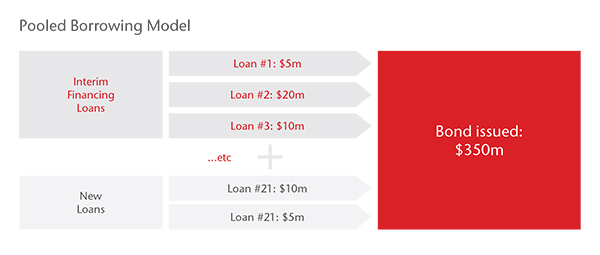What?
The First Nations Finance Authority (FNFA) is a nonprofit pooled borrowing group in Canada, governed by First Nations members (Indigenous Canadians).
FNFA aggregates the funding requirements from several First Nations governments into a bond of a suitable size and credit to access the international financial markets. FNFA was created under Canada’s federal First Nations Fiscal Management Act 2005, which defines how the organisation functions and the purposes for which loan requests can be made, such as infrastructure investment.
Through both new loans and refinancing existing bank loans, FNFA supplies capital to drive sustainable development and build governance capacities for First Nations across Canada. By August 2022, loans of CA$1.65 billion had been provided for projects including closing infrastructure gaps, improving social wellbeing, constructing affordable housing and supplying green energy. All loans are tied to ESG and UN Sustainable Development Goals tags.
The pooled model and FNFA’s positioning in the capital markets means that members can now access loans at 0.70% below prime bank rates. Investors receive income at an agreed rate, and FNFA generates a profit margin that covers its operational costs.
Through its work, FNFA has created over 17,000 jobs in Canada. With 634 First Nations in Canada and 146 FNFA members, there is scope for FNFA to scale within Canada, and the organisation is also working to share its model internationally.
FNFA uses its innovative capital markets expertise to offer very low interest rates on loans to First Nations governments to drive sustainable development amongst the indigenous community. Their approach is scalable, both within Canada and internationally.
Why?
In its early years, the Canadian government placed First Nations communities on reserves. The ramifications of this are still being felt today.
Federal funding to First Nations, when introduced, increased at a rate that fell short of population growth. First Nations did not legally own reserve lands so had no collateral they could use to get market interest rates on commercial bank loans.
This led to an increasing gap in funding for infrastructure and social provision.
To help address these gaps, First Nations governments themselves have done a large amount of economic development. They have revenue sharing agreements with provinces and companies.
But they needed more funding for infrastructure and social programmes that would bring the living standard of their inhabitants up to that of other municipalities.
The First Nations Fiscal Management Act 2005 created FNFA to give First Nations communities access to financing and to the capital markets at rates comparable with other levels of government in Canada. As well as low-cost loans, FNFA’s goal is also to support First Nations to strengthen their local governance structures, such as by putting in place finance and planning committees.
Our board is made up of our members. They approve the loans, they approve members who come in. There’s a lot of due diligence that goes in to selecting the makeup of the borrowing pool. We have a tagline that we say – and it’s very true – that we’re by First Nations and for First Nations. We’re led and governed by the First Nations.

How?
FNFA’s pooling model has robust governance and due diligence processes and good relationships with investors:
- A First Nation government must first become certified under the First Nations Fiscal Management Act before applying for FNFA membership. New members sign a borrowing agreement that outlines the mutual obligations between FNFA and the member.
- The annually elected FNFA board is made up of chiefs and councils of members. The board approves every new member and loan, checking eligibility under the Act and following a due diligence process. The annually elected FNFA board is made up of chiefs and councils of members. Board decisions must be unanimous.
- When a member applies for a loan, FNFA reviews the member’s revenue streams and assesses its borrowing capacity. Several loans then get packaged into one pool, which is sold as a debenture to the capital markets. If a potential member is not at a level where its loan would be suitable for the pool, FNFA will work with the First Nation to build up its financial capacity or advise it on restructuring its debt.
- For First Nations governments that want to borrow through the FNFA, FNFA uses a revenue intercept model to minimise risk of non-payment and so build investor confidence. This is based on the revenue contracts that every Canadian province has with First Nations governments. Under the revenue intercept model, the FNFA arranges with the relevant province that the province will send its agreed contractual revenues to an FNFA trust account rather than directly to the First Nations government. FNFA then draws money from the trust account to pay for the loan service and sends the remaining revenues to the First Nation member.
- Other safeguards for non-payment include FNFA building in a buffer of 23% when it determines how much a member can borrow. This ensures that no member overborrows. A debt reserve fund is also built up by placing 5% of borrowed amounts into a trust account so that if a member’s revenues are disrupted for any reason, the trust account can cover interest payments while the issue is resolved.
- In developing its approach, FNFA worked closely with investors throughout, from checking that the model’s safeguards would meet investors’ needs to ensuring that FNFA provides best practice information on ESG and SDG metrics. Telling its story to investors has also helped FNFA to build investor interest and sell its debentures worldwide.
- Other countries are now interested in adopting a similar approach. FNFA is talking to the central banks of Australia and New Zealand about its model.
Download the case study
Want a copy of this case study? You can download a PDF version using the link below.
